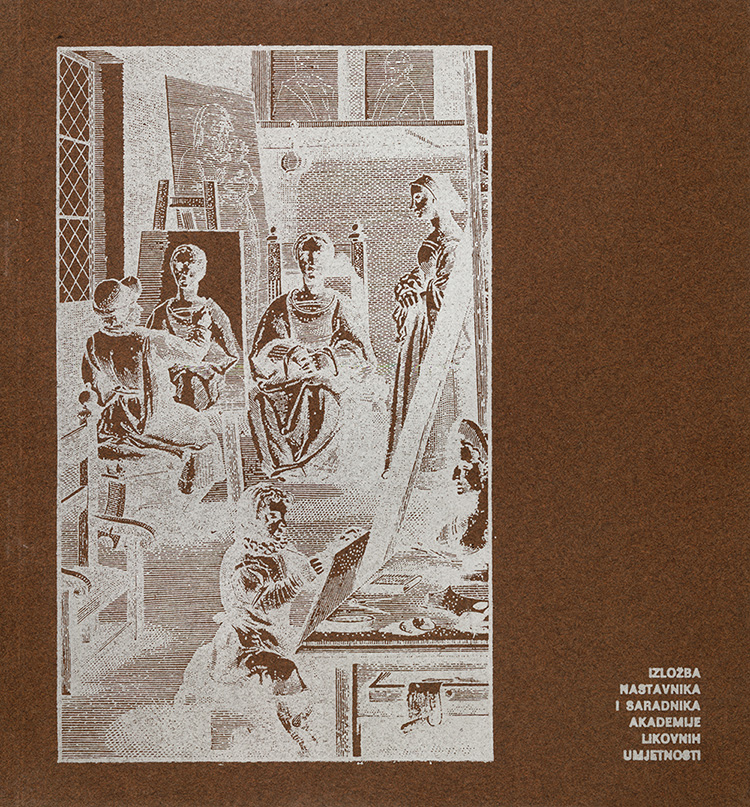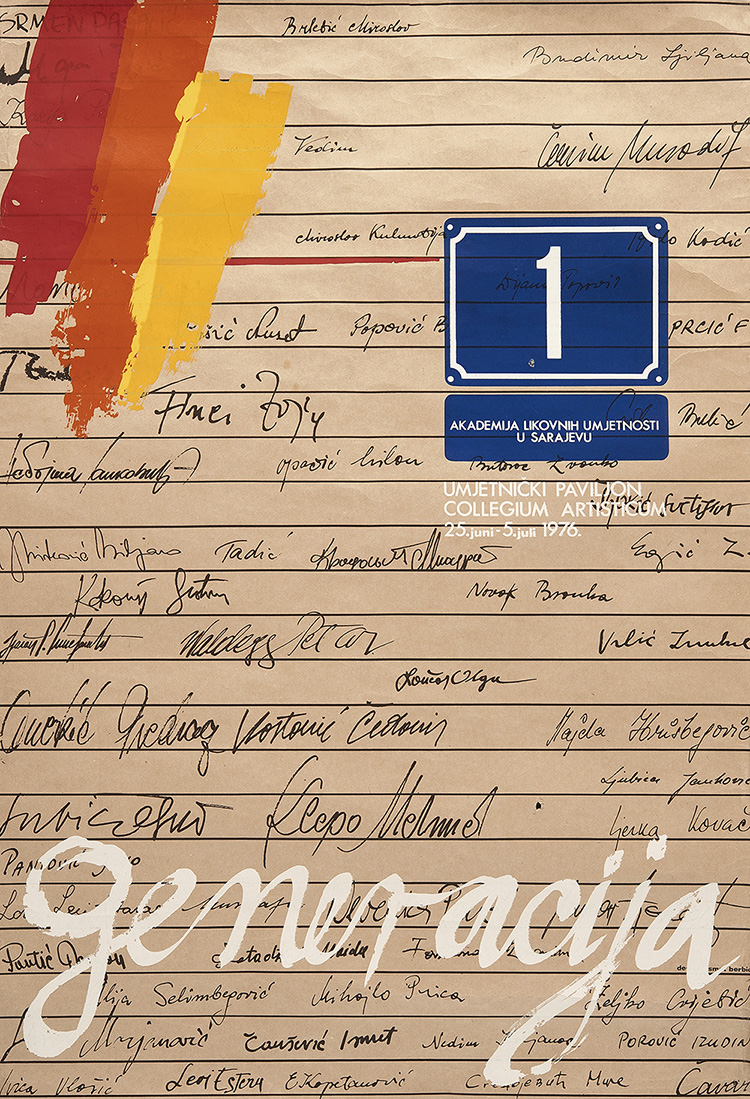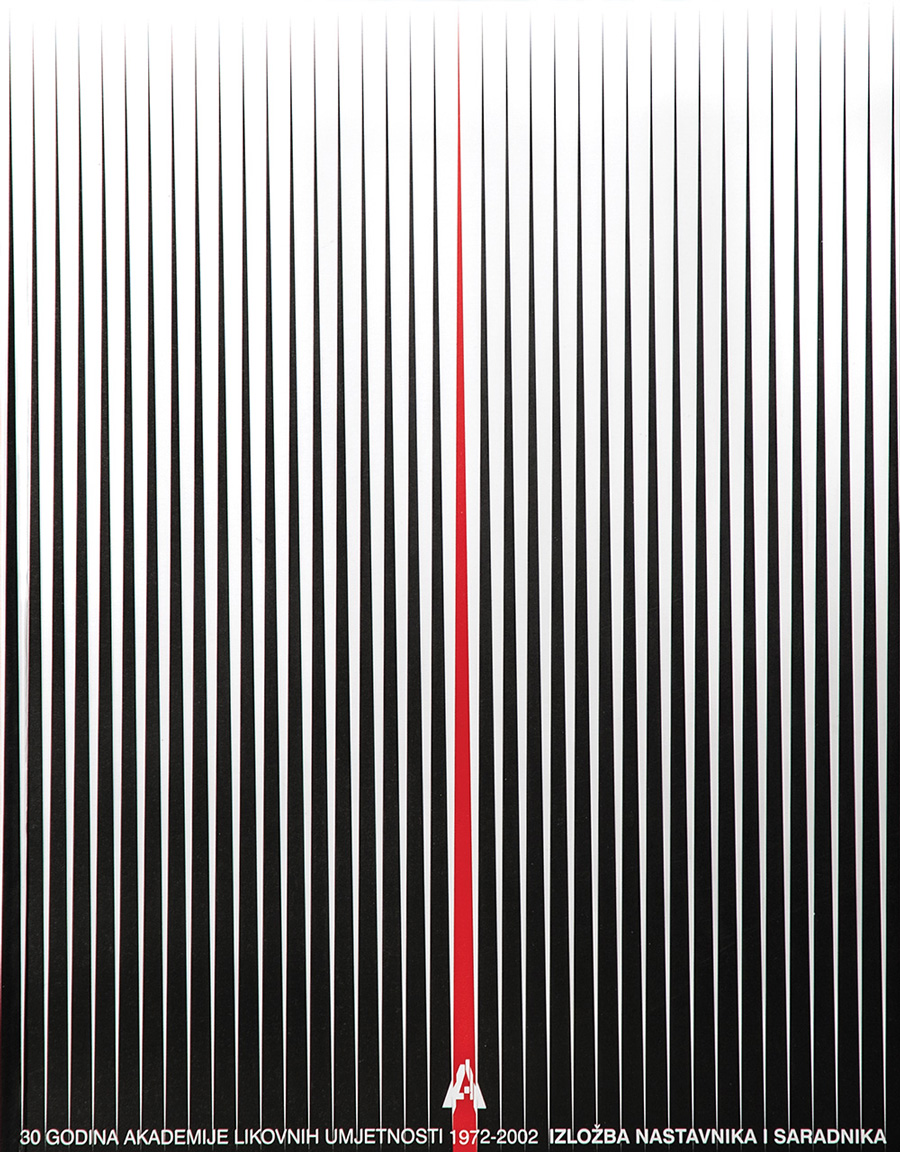The Academy of Fine Arts in Sarajevo was founded in 1972 as an institution that aims to educate artists and lecturers for the development of fine arts in Bosnia and Herzegovina. Muhamed Karamehmedović, an art historian from Sarajevo, on whose initiative this institution has been founded, became its first dean.
The basis of the teaching staff were those artists who by that time had already established themselves in the wider cultural space, both in Yugoslavia and on the international scene: Mersad Berber, Borislav Aleksić, Nada Pivac, Zdenko Grgić, Alija Kučukalić, and then Dževad Hozo, Seid Hasanefendić , Ismar Mujezinović, Mladen Kolobarić, Salim Obralić, Milivoje Unković, Ratko Lalić, Sead Musić, Ljubomir Perčinlić.
Successful first generation students became assistants and then professors (Nusret Pašić, Mustafa Skopljak, Petar Valdeg, and Mirsad Šehić, Fikret Libovac, Bojan Hadžihalilović, ...).
From the beginning, the Academy organized the study of design, with the first graphic under the direction of Mladen Kolobarić, and since 1984, a product design for which Zlatko Ugljen, Zdenko Praskač and Živojin Vekić were also engaged.
The first decade of the Academy's operation passed in such a way that classes took place in rented premises in the building on the Obala, at the Pedagogical Academy, the Faculty of Civil Engineering and the Faculty of Veterinary Medicine. The Academy got its permanent working space, its building, in 1982. In the period from 1979 to 1981, the previously neglected building of the Evangelical Church in Sarajevo was renovated.
In organizational terms, the Academy today consists of several study groups organized through departments and chairs: a) pedagogical study (teaching department), b) art study (painting department, sculpture department, printmaking department), c) design study (graphic department, product design department) , and e) interdisciplinary study of conservation and restoration organized in cooperation with the Faculty of Natural Sciences and Mathematics and the Faculty of Architecture, University of Sarajevo.
Since its founding until today, over 3,500 students have been enrolled in undergraduate and master studies at all study groups. Many of the students of the Academy of Fine Arts have gained the status of recognized artists, lecturers and designers both on the domestic and international art scene, many of them have become excellent lecturers and professors at other art schools and academies in the region and the world, or design leaders in various world companies.
The first years of the Academy, its first decade, are the years of operation of the Art Pavilion and the founding of the Collegium artisticum. They coincide with the development of popular culture and the emergence of the Sarajevo Pop School. Jadranka Stojaković, a student of our academy, is an active participant in this scene. Besides her, Dragan S. Stefanović, a painting student who will cover long play records with his creations for the bands Bijelo dugme, Indexi, Ambasadori, the COD, the Korni group, Time, Smak, ... became one of the most important designers in that field in Yugoslavia.
The new, young forces of our art scene were Muradif Čerimagić, Mirza Morić, Nusret Pašić, Mustafa Skopljak, Radoslav Tadić, Petar Valdeg, Branko Bačanović, Anto Kajinić, ...
The 1980s were the years of the XIV Winter Olympic Games, during which the academy became an important organizational and promotional point. Our professors and students: Mladen Kolobarić, Ismar Mujezinović, Čedomir Kostović, Branko Bačanović, Branko Modraković, Srdjan Kokoruš, Lora Levy actively participated in the creation of the visual identity of the Olympics.
The eighties and the years of the festival, primarily the Sarajevo Winter, which was carried away by the positive spirit of the Olympics, strongly promoted the culture of Bosnia and Herzegovina, but also numerous other sports and cultural events.
In cooperation with Energoinvest, in the former house of Mak Dizdar, in Baščaršija, the Academy started the work of a gallery for graphics, in which it represented several authors from the domestic and international art scene until the end of the eighties. Among them is an exhibition of drawings by world-famous British artist David Hockney.
Yugoslav documents, the Biennial of Contemporary Yugoslav Art held in 1987 and 1989 in the center of Skenderija sublimated numerous art activities, both on our and the wider Yugoslav art scene, and opened space for new artistic practices and new authors.
The 1980s are also the years of operation of the art group Space - Shape, which consisted of already established artists Bekir Misirlić, Ljubomir Perčinlić, Tomislav Dugonjić, Edo Numankadić, and associates Vojo Dimitrijević, Radoslav Tadić and Mustafa Skopljak. The Zvono art group, founded by academy students Aleksandar Saša Bukvić, Biljana Gavranović, Sead Čizmić, Narcis Kantardžić and Sadko Hadžihasanović, also operates alongside them.
The war years did not discourage teachers and students of the academy either. In conditions of extreme scarcity and struggle for a bare life, teachers and students tried to defend their human, cultural and civilizational orientations with their work. At the initiative of Salim Obralić, a map of graphic sheets Sarajevo was created in 1992, and maps were published for 1993, 1994 and 1995. Nusret Pašić reacts with the exhibition Witnesses of Existence in the War-Destroyed Sutjeska Cinema. After him, several authors put their Witnesses of Existence (Ante Jurić, Sanjin Jukić, Zoran Bogdanović, Radoslav Tadić, Edo Numankadić) in the same place.
Our student Omer Halilhodžić is designing his first CZ and CZ 2 car models for Mitsubishi - Europe.
Obala Art Center in the large hall of the academy is building and editing the Obala gallery, which hosted many world artists during the war years (Christian Boltanski, Antony Gormly, Annie Leibovitz, Danica Dakić, ...). The Center for Contemporary Art was founded at the academy under the leadership of Dunja Blažević.
In memory of prof. Alija Kučukalić who was tragically killed in the war, the Academy established the Annual Award for the best student "Alija Kučukalić", which has been awarded from 1997 until today. Its first laureate in 1997 was Nebojsa Seric Shoba. Maja Bajević and Šejla Kamerić appear on the international art scene.
With the new millennium, after 2000, the academy presented itself in a new face. The study of design, both graphic and product design, are becoming more and more visible in the public space. Students of graphic design under the guidance of prof. Bojan Hadžihalilović organizes the SOS festival and gathers numerous regional and world names from the world of design at exhibitions, workshops and lectures. Our student Sasha Vidaković is successfully working on the world design scene with her company SVDesign London, working for partners such as Victoria Beckam, Hermes, and others.
Since 2006, Salih Teskeredžić has been regularly exhibiting his works at the Cologne Fair. The positive impact of these initiative can be seen by students Nataša Perković and Mustafa Čohadžić, who were winners of significant awards for design at international design fairs, but also Amila Hrustić (Prague), Sajdin Osmančević (Beijing), Mahir Hodžić (Munich) who successfully worked on international design scenes.
Of course, this is just one of many possible images of the academy, its students and teachers. Every other student of this school could tell their story and highlight some other, important and valuable events and people.
The illustrations that accompany this jubilee, which we have chosen for this exhibition, aim to refresh the memories of some important moments from the life of this institution.
Today, the academy lives and works motivated by the successes of its students and professors, marking its 50th anniversary.
1972-1982










1982-1992










1992-2002










2002-2012










2012-2022










